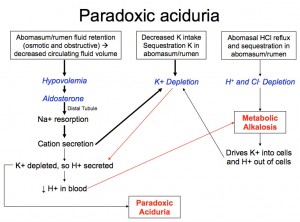Paradoxic aciduria can be a feature of a primary metabolic alkalosis due to vomiting or sequestration of hydrochloric acid-rich gastric contents in all species, but particularly ruminants. In this example of a ruminant with abomasal displacement, hydrochloric acid-rich and electrolyte- and water-rich secretions are sequestered in the displaced abomasum. The kidney becomes sodium avid. Chloride depletion results in increased sodium delivery to the late distal tubule and collecting ducts. Sodium is taken up by a transporter (eNac) which creates a luminal negative potential difference, which drives hydrogen excretion via a sodium-dependent antiporter. Reduced NaCl absorption (salt sensing) in the macula densa from hypochloremia (not shown) and hypovolemia stimulates aldosterone, which promotes sodium absorption in the distal convoluted tubules of the kidney. Normally sodium is exchanged for potassium in response to aldosterone, however potassium is concurrently depleted (moves intracellularly in exchange for hydrogen in an alkalemia, lost in gastric secretions, decreased intake due to anorexia) so sodium is exchanged (resorbed) for hydrogen (excreted) resulting in a paradoxic acuduria.

